What Do Starfish Eat? – Lesson for Kids
Suzanne has taught all levels PK-graduate school and has a PhD in Instructional Systems Design. She currently teachers literacy courses to preservice and inservice teachers.
Christianlly has taught college Physics, Natural science, Earth science, and facilitated laboratory courses. He has a master’s degree in Physics and is currently pursuing his doctorate degree.
Investigate the diets of starfish and their many species. Discover defining characteristics of starfish anatomy, how they eject their stomachs to eat, and what organisms serve as their prey. Updated: 01/10/2022
Starfish or Sea Stars?
The animal that you know as a starfish is getting a new name! Marine biologists are trying to get people to start calling them sea stars instead of starfish because they aren’t really fish. They’re actually related to sea urchins and sand dollars, and they only live in saltwater, not freshwater.
A sea star is an invertebrate animal, which means that it doesn’t have a backbone. There are many different kinds of starfish, some of which can live as long as 35 years in the wild. They aren’t really very small; starfish can grow to be as much as 9 inches across and they can weigh up to 11 pounds. Some starfish need to eat every day, while some can go much longer without eating.
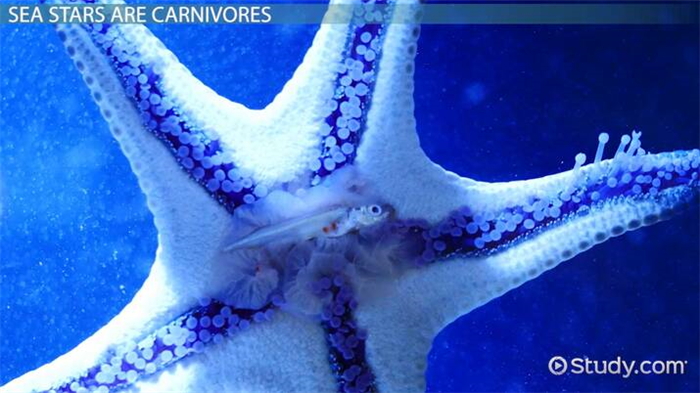
An error occurred trying to load this video.
Try refreshing the page, or contact customer support.
You must c C reate an account to continue watching
Register to view this lesson
As a member, you’ll also get unlimited access to over 84,000 lessons in math, English, science, history, and more. Plus, get practice tests, quizzes, and personalized coaching to help you succeed.
Get unlimited access to over 84,000 lessons.
Already registered? Log in here for access
Resources created by teachers for teachers
I would definitely recommend Study.com to my colleagues. It’s like a teacher waved a magic wand and did the work for me. I feel like it’s a lifeline.
You’re on a roll. Keep up the good work!
Just checking in. Are you still watching?
- 0:04 Starfish or Sea Stars?
- 0:47 Sea Stars Are Carnivores
- 3:05 Lesson Summary
Want to watch this again later?
Log in or sign up to add this lesson to a Custom Course.
Sea Stars Are Carnivores
Believe it or not, a starfish (or sea star) is a carnivore, which means it eats other animals. Because starfish are very slow movers, they eat animals that also move slowly. They usually feed on coral, sponges, clams, oysters, sand dollars, and mussels because these animals also attach themselves to rocks and move slowly, so they’re nearby.
Some starfish will also eat other animals, such as fish, if they are injured and unable to move away in time. Starfish also eat animals and plants that are already dead and decomposing on the beach or in the rocks.
Starfish eat in a very unusual way. They use their feet, which have suction-cups on the bottom, to help them hold on to their prey. Once they have a good grip on dinner, they use their feet to open it up if it’s a clam or oyster. Once it’s opened, the starfish’s stomach actually comes out of its mouth, and pushes itself inside of the clam or mussel shell. The stomach surrounds the edible parts of the animal and digests it, and doesn’t return back into the starfish’s mouth until dinner is turned into a soupy liquid.
Once the stomach returns inside, the starfish uses its ten digestive glands to finish digesting the animal it has eaten. Scientists who study starfish have found that there is a special molecule in starfish, called a NGFFYamide, that tells the stomach when to go in and out of the starfish. This is an important finding, because scientists can now use this information to help control the feeding of starfish so that they don’t cause destruction in certain areas of the ocean where there are endangered animals. For example, in the Great Barrier Reef in Australia, starfish are eating corals that are needed to help rebuild the reef. Scientists can use their understanding of the NGFFYamide molecule to keep starfish from eating these corals so that the Great Barrier Reef can be naturally rebuilt by them.
If you happen to have a saltwater aquarium with a pet starfish, you can feed it the same things it would eat if it was in the wild. Clams or mussels, which can be bought at the grocery store, are good choices for a pet starfish, and they can also be fed frozen shrimp.
Lesson Summary
Starfish, or sea stars, are invertebrate animals, which means they don’t have a backbone, that live in saltwater habitats. They are carnivores that eat other animals like clams, mussels, coral, and other small, slow-moving animals who live near them or that they find already injured or dead. Starfish have a special molecule, called the NGFFYamide, that helps them feed by controlling when their stomachs go in and out of their mouths to digest their prey.
To unlock this lesson you must be a Study.com Member.
Create your account
What Do Starfish Eat? 12-Plus Amazing Foods in Their Diet
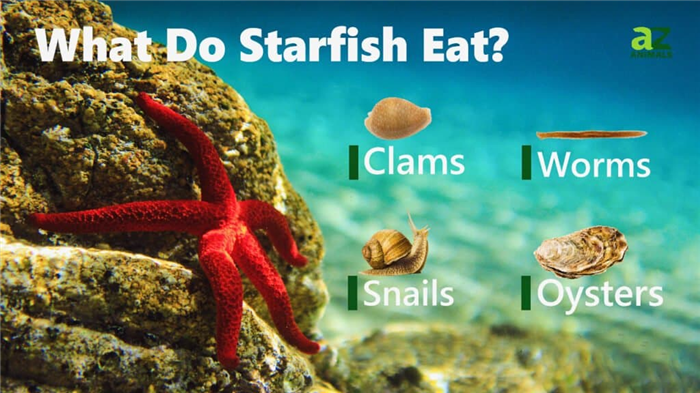
Starfish eat foods ranging from snails, to oysters and calms, to marine worms!
Starfish, also known as sea stars, are incredibly unique and bizarre invertebrate animals that have an almost alien-like appearance. They are part of a group of animals known as echinoderms, which notably have radial symmetry rather than bilateral symmetry like most animals. The Echinodermata phylum also includes sea urchins, sea cucumbers, and sand dollars! One of the most common questions asked about these one-of-a-kind animals is “What do starfish eat?”
Furthermore, how do they find and eat their food, anyway? Finally, where is a starfish’s mouth? Read on as we answer the many questions you probably have about the enigmatic starfish, one of the most unusual and captivating animals to ever live in our planet’s vast seas.
How Do Starfish Eat?
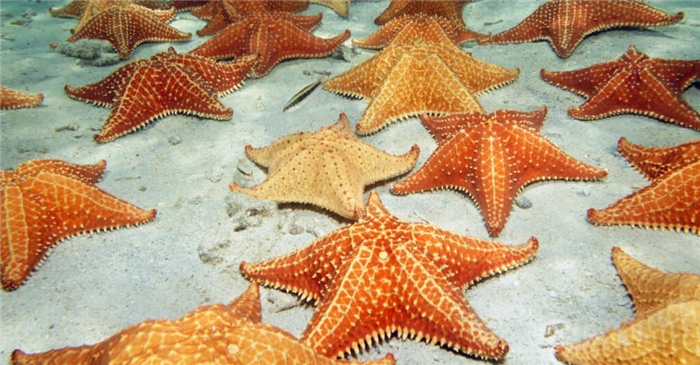
A group of starfish sitting on the ocean floor
Before we get into what sea stars eat, it helps to first understand their extraordinary biology and how they find and eat food.
Amazingly, starfish don’t digest their food inside of their bodies like most animals do. They actually are able to expel their entire stomachs through their mouths in a process known as eversion!
Starfish scoot along the sea floor by using hundreds of tiny structures called tube feet that are attached to the bottom of each of their arms. They fill these tiny “feet” with water and contract and relax them rapidly, which allows them to move surprisingly quickly from place to place (and, more importantly, towards their next meal!).
When a starfish finds something it wants to eat, it will quickly propel itself towards its prey and prepare itself for the eversion process.
A starfish’s mouth is actually located on the underside of its body, more specifically in the center where its limbs all meet. From this mouth, a starfish will extend its stomach and use it to completely envelop its prey, like a clam or a sea snail. Next, their stomach begins secreting digestive enzymes to break down the prey animal’s body, in turn making it easier to pull it back into the starfish’s mouth.
Finally, the starfish will pull its stomach back into its mouth with the prey animal trapped inside. The sea star then lets its many internal digestive glands finish the animal off. It’s a truly strange survival tactic, but it works perfectly for such a strange animal!
What Do Starfish Eat?
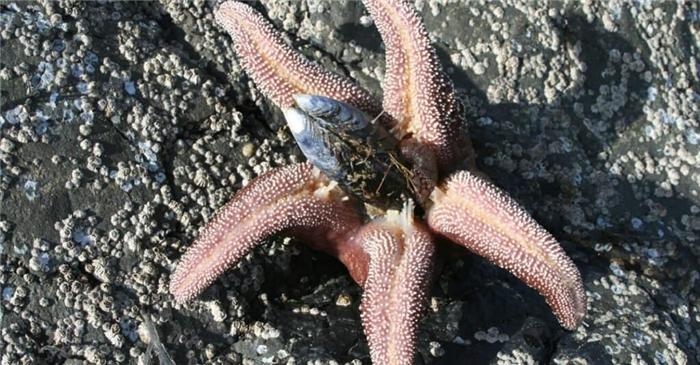
A starfish feeding on its prey
Now that you have a better understanding of how starfish use their bodies to move around and capture their prey, we can get into the many foods these unusual animals eat.
Of the roughly 2,000 species of starfish, nearly all of them are carnivorous. This means they feed primarily on the flesh of other animals living in the ocean.
A large portion of a typical starfish’s diet is composed of various species of shelled mollusks, which the starfish is able to break open with their powerful, suction-cupped feet. However, they are known to feed on lots of other small prey animals, too.
Here are the many animals starfish commonly eat:
- Clams
- Mussels
- Snails
- Worms
- Sand dollars
- Plankton
- Decomposing organic matter
- Other starfish
- Small crustaceans like hermit crabs and shrimp
Do Starfish Have Predators?
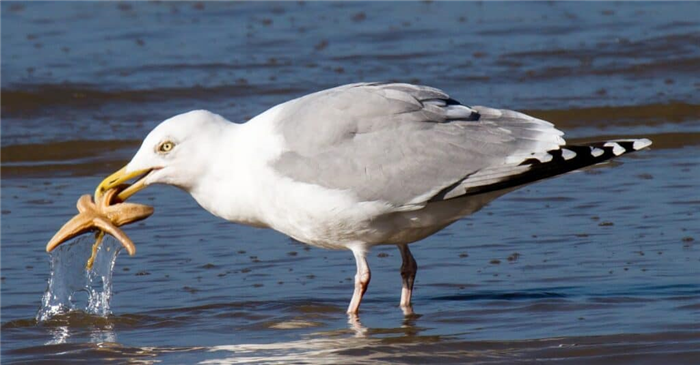
A seagull preparing to eat a starfish
Starfish have a few helpful defense mechanisms that keep a lot of major predators away. Most notably, they have a very rough, bone-like exoskeleton that is unpalatable to many animals, and the suction cup-like structures on their feet make them very difficult to peel off of surfaces like rocks.
Despite these clever defenses, though, starfish have a wide range of predators that feed on them in the ocean. Here’s a list of animals that commonly eat starfish:
- Sharks (mostly bottom-feeders like nurse sharks)
- Rays
- Other starfish
- Large snails
- Sea birds
- Large bony fishes
Share this post on:
Hailey Pruett
Hailey Pruett is a freelance content writer, editor, and lifelong animal lover living in Tennessee with their spoiled cat, grumpy leopard gecko, and loving partner. Their favorite animals are lizards, turtles, snakes, and frogs. When they aren’t obsessively writing about how awesome reptiles and amphibians are, Hailey is usually playing relaxing life simulator video games and obscure, old-school RPGs. They are non-binary and comfortable with any pronouns.
Sea Stars
Sea stars are invertebrates related to sea urchins, sea cucumbers and sand dollars, which are all echinoderms. Echinoderm means spiny skin—a reference to their hard, calcified skin, which helps to protect them from predators.
Sea stars have rows of tiny tube feet extending from the grooved surface on their underside. These tube feet allow them to crawl along the ocean floor using suction created by an internal water-driven hydraulic system. These animals also have an amazing ability to regenerate arms when they are severed, or even a new body in some species. All of their vital organs are located in the arms, so a portion of an arm could potentially grow a whole new sea star.
There are close to 2,000 species of sea stars in the world’s oceans. Most species have five arms, but some have many more—even as many as 40! At the Aquarium, you can see 10 species of sea stars throughout the exhibits. Look closely in the kelp forest habitat to spot the sun sea stars, which have 20 arms each!
A Note From the Caretaker
At the Aquarium, we feed some of our sea stars pieces of fish and shrimp, but the majority of our sea stars feed on detritus, which helps to keep their habitats clean.
Learn more about sea stars! Did you know that sea stars have a peculiar way of eating? They digest prey outside of their bodies by extruding their stomach out through their mouth and enveloping their meal. Once the food is digested, their stomach is drawn back into their body.
Sea stars live in salt water and are found in all of the world’s oceans, from warm, tropical waters to the cold seafloor.
Sea stars are mostly carnivorous and prey on mollusks—including clams, mussels and oysters—which they pry open with their suction-cupped feet.
The smallest sea stars are less than an inch in diameter, while the largest sea stars can reach up to 3 feet in diameter.
Many different animals eat sea stars, including fish, sea turtles, snails, crabs, shrimp, otters, birds and even other sea stars. Though the sea star’s skin is hard and bumpy, a predator can eat it whole if its mouth is large enough. Predators with smaller mouths can flip the sea star over and eat the softer underside.
What do Starfish Eat? – Starfish Diet
Did you know that starfish are among the most widely distributed marine animals in the world? Most starfish, or sea stars, live among deep ocean floors and for this reason, their habitat is unknown to many people. Starfish are incredibly interesting echinoderms who eat, reproduce and move in fascinating ways.
If you’re asking yourself, ‘‘What do starfish eat?’’ Keep reading here at AnimalWised to find out. In addition, we’ll be discussing starfish reproduction, starfish habitat as well as including some fun starfish facts!
How do starfish move?
Starfish, also known as sea stars, are invertebrates that belong to the class Asteroidea and inhabit the deep sea. Starfish are characterized by their flat bodies from which multiple arms protrude, depending on the species. The ‘‘limbs’’ have suckers which they use to help them move. These suckers are also referred to as “ambulatory feet”.
Starfish characteristics
A starfish’s mouth is located in the middle of the flattened part of its body.
A starfish’s skin is composed of calcium and may have carry a grainy, rough, smooth and/or hard texture. Most starfish species are distinguished by their bright colors (blue, red, white). There are, however, many species that also present simple tonalities which aid them in camouflaging themselves, specifically when threatened.
You may also be wondering, ‘‘Do starfish have eyes?’’ And although they are not very visible, starfish do have eyes. A starfish’s eyes, however, are not like ours and are more commonly referred to as eyespots, a type of light detector at the end of their arms.
Starfish fun fact: Starfish have no brain or blood, instead they use a water vascular system that pumps nutrients through their bodies.
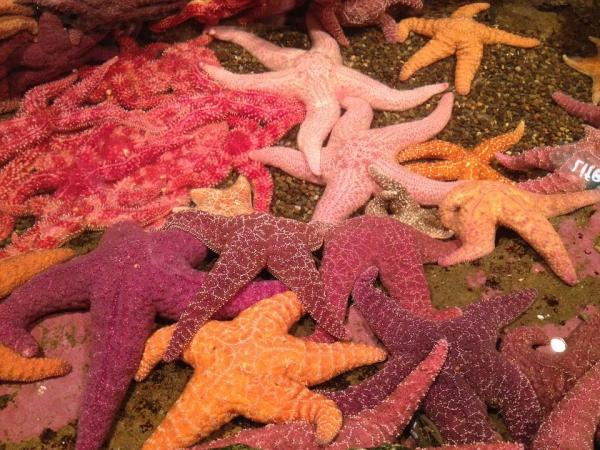
Where do starfish live?
Starfish are distributed among oceans all over the world. They can be found in the Arctic, Antarctic, Atlantic, Indian and Pacific ocean. Most starfish species prefer to live at roughly 6,000 meters deep, although some can also be found inhabiting sandy beds on ocean coasts.
Starfish can only survive in salty and brackish environments, therefore, you won’t find them in fresh water. A starfish’s favorite place to settle commonly include coral reefs, seaweed forests and muddy sands. Due to the fact that starfish are nocturnal, they can live comfortably within the low light environment of the deep ocean floor.
How do starfish reproduce?
Considering the unique appearance of these invertebrates, it’s quite normal to wonder, ‘‘How do starfish reproduce?’’. Well, simply put, there are two types of starfish reproduction, which include:
Starfish sexual reproduction
The majority of starfish species can be both male and female. Many starfish species have the ability to change gender as they get older, meaning that a starfish is born a specific gender which can change when they reach adulthood or old age.
When it comes to starfish reproduction cycle, a starfish releases gametes (sex cells) through the gonads in its arms. Once the eggs are released, a male starfish will release sperm to fertilize them. In the case of hermaphrodite starfish species, it is possible that both parts of this process are carried our by the same individual.
Once the eggs are released, there are two routes which the starfish reproduction cycle can take:
- They may develop as part of the plankton, whereby the mother will incubate them and protect them with her body.
- They may grow attached to a rock.
Once the right size, the eggs give way to the larvae, which swim or float in the sea. As they become adults, the morphology of their body changes and they will progress to inhabit the seabed.
Asexual reproduction in starfish
Other species of starfish follow an asexual reproduction cycle. Some do not require the intervention of another individual, because they have both male and female gonads.
Another asexual reproduction process in starfish is budding. Budding constitutes the creation of an individual that grows attached to the parent, which only separates once developed. This method is common in starfish larvae that live in environments with abundant food.
Starfish fun fact: A female starfish can produce millions of eggs at once, but only a few of these will become adult starfish.
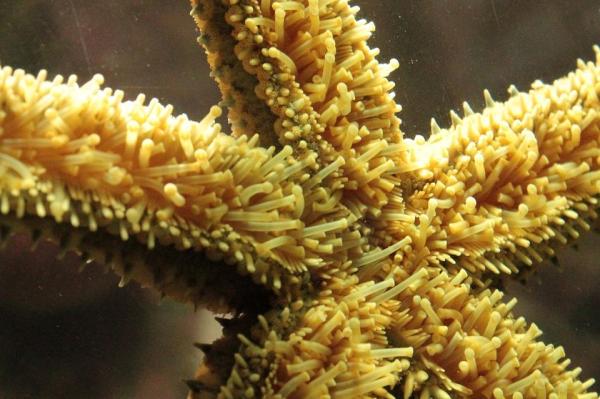
Types of starfish
There are over 2000 different types of starfish in the world and their characteristics vary:
- Paxillosida order: includes 255 species. There do not have suckers or an anus and prefer to live half-buried in sand or sea mud. They usually occur in abundance of individuals in the areas they inhabit.
- Valvatida order: includes 695 species. They have five arms with suckers, in addition to a visibly calcified body.
- Velatida order: includes 210 species. They are hexagonal-shaped and can have between 5-15 arms with suckers. This order inhabit cold waters, such as polar and subpolar regions.
- Spinulosida order: includes 120 species. They have a fluid -like skeleton and carry a rough textured body with horns.
- Forcipulatida order: includes 300 species. They have powerful sawed jaws, and are threatening predators. They prefer colder waters.
- Brisingida order: includes 111 species. They can have between 6-20 arms without suckers. They prefer to live in deeper water.
- Notomyotida order: includes 75 species. They can have arms with or without suckers, accompanied by a muscular body.
Starfish fun fact: The most common type of starfish, found in the northeast Atlantic ocean, is known as the ‘‘common starfish.’’
What do starfish eat in the ocean?
Most starfish are carnivorous and predatory, which means that they hunt their own prey. A starfish’s main source of food includes; crustaceans, sea urchins, smaller fish, plankton, clams, mussels, snails, sea cucumbers, coral polyps, anemones, basically any animal slow enough to be able to ingest.
Now, how can starfish, white-bodied and defenseless, devour such a variety of prey? Well, a starfish’s stomach is evaginable, which means that they are capable of “expelling” it out of the body. When catching prey, starfish surround it with their arms to which they eject their stomach to cover the prey in digestive juices, initiating the decomposition of the victim. Then, they fold their stomach back and swallow their prey.
There are other starfish species, however, that feed only on decaying matter, be that of plant or animal origin.
What do chocolate chip starfish eat?
The chocolat chip sea star is one of the most famous star fish species among starfish lovers. These starfish are scavengers as well as predators and will feed on muscles, snails, shrimp, squid and/ or even coral.
Watch this YouTube video below, posted by @n2oBlazer, to see how a starfish would ingest a crustacean:
What do sea urchins eat?
Sea urchins are echinoderms that are usually found in spaces which starfish inhabit. They are characterized by their round body full of rigid spikes.
Now, what do sea urchins eat? Well, most sea urchins are herbivorous animals, so they feed on algae found on seabeds. Some, however, are detritivores, which means that they eat decaying matter, while others are predators and feed on slower and smaller animals.
Did you know that the red sea urchin is one of the longest living animals in the world? For more, read our article where we discuss which animals live the longest.
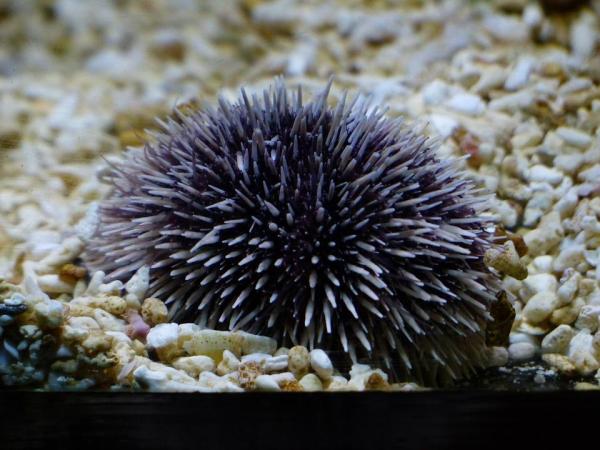
What do sponges eat?
Sea sponges are invertebrates (phylum Porifera) and there are about 9000 species in the world. For a long time sea sponges were thought to be marine plants, mainly due to their peaceful lappearance that lacks recognizable structures, such as eyes, mouth, etc.
With regard to feeding, sea sponges eat nutrients through phagocytosis. Phagocytosis is the means by which cells surround food particles and decompose them to absorb them. Sometime sponges also feed though pinocytosis, the same process, but carried out with fluids (rather than solids). Thanks to these such methods, sponges are able to feed on small particles of decaying matter, microscopic algae and marine bacteria.
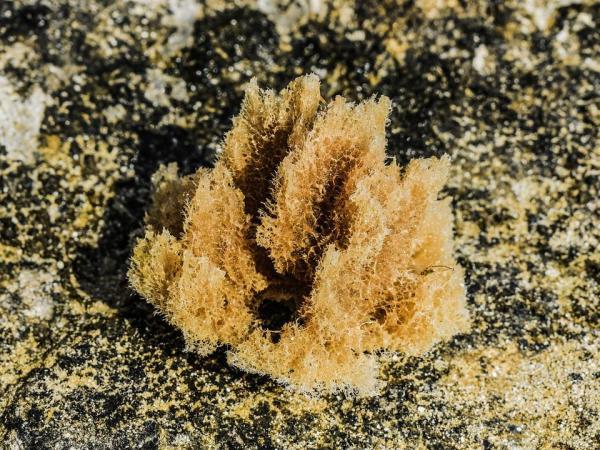
What do clams eat?
Clams is the umbrella name for several types of bivalve molluscs. Clams, as well as being a popular starfish food, are indiscriminate filter-feeders. This means that they ‘‘breath in’’ water for both oxygen and food and feed on the suspended particles in the water which they suction in.
Lastly, you may be wondering, what do starfish eat in an aquarium? Well, it really depends on the type of starfish you have. As we’ve already mentioned, sea stars in the wild are carnivorous predators, so simply feeding them fish flakes is not sufficient.
We recommend consulting your local aquarium for some great starfish food options. One thing we do know is that they love to eat mollusks. Offer your starfish some mussels and/or clams and see what happens (make sure to clean them properly beforehand).
We do have to emphasize that before getting a starfish, you have to make sure you educate yourself well about its needs and requirements. Starfish are not a tank decoration! They require proper care and an appropriate diet.
If you want to read similar articles to What do Starfish Eat? – Starfish Diet, we recommend you visit our Healthy diets category.
Disclaimer
At Kidadl we pride ourselves on offering families original ideas to make the most of time spent together at home or out and about, wherever you are in the world. We strive to recommend the very best things that are suggested by our community and are things we would do ourselves – our aim is to be the trusted friend to parents.
We try our very best, but cannot guarantee perfection. We will always aim to give you accurate information at the date of publication – however, information does change, so it’s important you do your own research, double-check and make the decision that is right for your family.
Kidadl provides inspiration to entertain and educate your children. We recognise that not all activities and ideas are appropriate and suitable for all children and families or in all circumstances. Our recommended activities are based on age but these are a guide. We recommend that these ideas are used as inspiration, that ideas are undertaken with appropriate adult supervision, and that each adult uses their own discretion and knowledge of their children to consider the safety and suitability.
Kidadl cannot accept liability for the execution of these ideas, and parental supervision is advised at all times, as safety is paramount. Anyone using the information provided by Kidadl does so at their own risk and we can not accept liability if things go wrong.
Sponsorship & Advertising Policy
Kidadl is independent and to make our service free to you the reader we are supported by advertising.
We hope you love our recommendations for products and services! What we suggest is selected independently by the Kidadl team. If you purchase using the buy now button we may earn a small commission. This does not influence our choices. Please note: prices are correct and items are available at the time the article was published.
Kidadl has a number of affiliate partners that we work with including Amazon. Please note that Kidadl is a participant in the Amazon Services LLC Associates Program, an affiliate advertising program designed to provide a means for sites to earn advertising fees by advertising and linking to amazon.
We also link to other websites, but are not responsible for their content.
